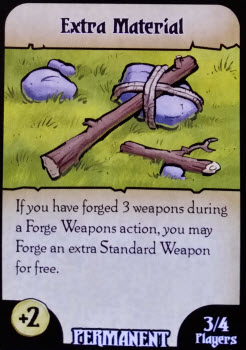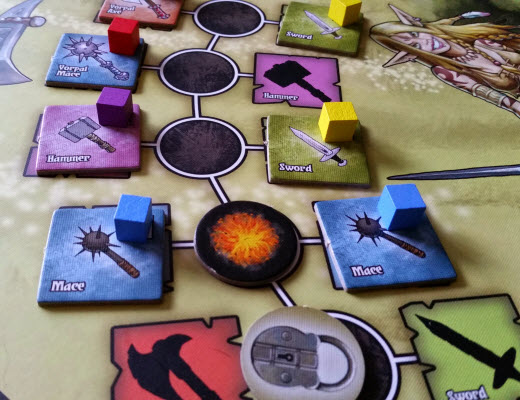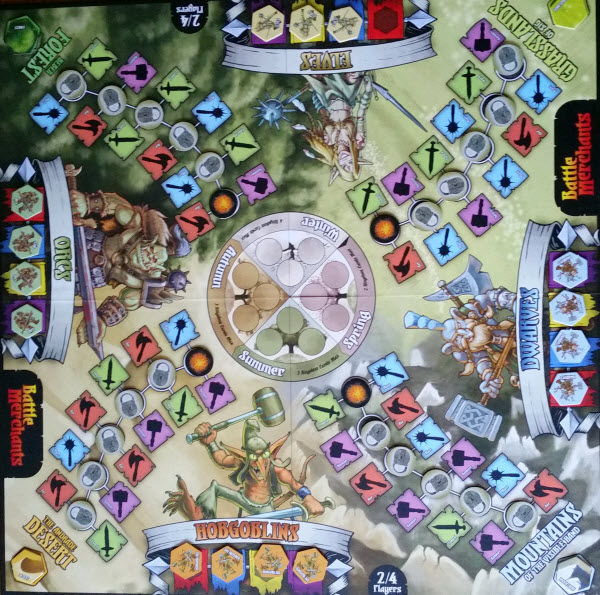Wiping the blood from from the hilt, Scrog glanced over at his unwilling participant in the vorpal blade’s visual demonstration. You wisely kept your cool as the grunt known as M’rik became a living test dummy for the weapon’s effectiveness, the surrounding snow covered in a rust-colored stain. No flinching. Showing hesitation now would raise concerns. Plus, he can still fight as well as any Orc with just one arm anyhow. Probably.
“Scrog is pleased with axe quality. Blades are sharp, do not dull easily. How many you have to sell to Orcs?”
Showtime.
You pause, feigning like you’re weighing his question carefully. Then you flash a wide and toothy grin. ‘Why I do suppose that depends on how much gold you’re willing to spend…”
The Premise
Schisms run deep in this fantasy realm, as the races of Dwarves, Elves, Hobgoglins, and Orcs have renewed their heated and ancient grudges against one another. Yet the only stake players have in the matter are with whoever is willing to pay the most. As arms dealers, each player seeks to be the best peddler around by crafting, upgrading, and selling their weapons wherever is the most profitable. The winds of war blow yet again, and it’s time to get those wares to market.
The Rules
Played out over a four seasons, Battle Merchants is an economics game about profiteering. In it, several races are fighting a two-front war. Between each race lies a contested region with a series of battlefields, each denoting which weapon that race is demanding. The goal is to give them what they want. The game starts with only the first battlefield of each region active and a handful of Kingdom and Craft cards revealed.
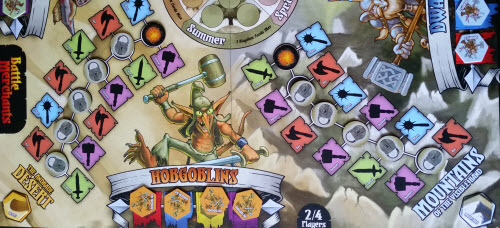
Down Down to Hobgoblin Town…
Aka the Hobgoblin board region.
To begin, each player receives gold a player board. Each player starts with the ability to create two weapon types and a bonus for selling to a specific race. The starting player is the last person to sell a weapon to an Orc…or is determined randomly.
On each player’s turn, they choose to either Upgrade a weapon, Forge weapons, Sell a weapon, or Take a Kingdom Card.
Upgrading involves selecting a Craft Card and paying its cost, if any. Craft Cards raise the strength of one or more of a player’s weapons by one or two ranks, and some Craft Cards also provide cost reductions.
Forging Weapons builds up inventory. A player may Forge up to three weapons at a time by paying the costs and taking the appropriate weapons. Players may always create Standard weapons, but superior Vorpal weapons become available at rank five.
In Battle Merchants, the first player to reach rank six of any weapon also gains a special fifth Master Craftsman action. Once per season, that player may use that action to Forge one weapon of that type and immediately Sell it.
Selling a weapon is at the heart of Battle Merchants. To Sell, players place a weapon on any unlocked battlefield space matching that weapon and collect money equal to the sale price plus every Reward Tile they have of the race it’s being sold to. If they haven’t collected that race’s Reward Tile that season, they take one.
Lastly, Taking a Kingdom Card lets players gain money or abilities, and they come in Permanent or One-time formats. Permanent Kingdom Cards cannot be disposed of, though, and players are limited to between two and four.
Whenever an active battlefield has both weapon slots filled, the active token is moved to the Season Tracker and the next battlefield becomes unlocked. Once all three Tracker spaces of the current season are filled, the round ends. In each area with two clashing weapons, players compare the ranks of their weapons. Vorpal weapons always defeats Standard weapons, but otherwise the winner is determined by weapon rank. The winner claims the defeated weapons as tokens, and players collect residual gold for each weapon still on the battlefield.
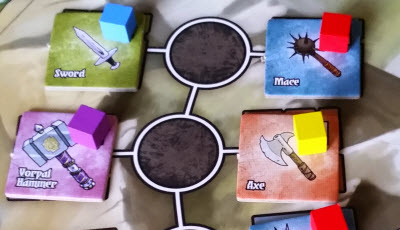
Blue’s Rank 1 Sword loses to Red’s Rank 3 Mace, and the Vorpal Hammer smashes the normal Axe.
After that, a new round begins. The player who triggered the end of the previous round begins anew.
Play continues until the end of the fourth season. At that point players cash in unsold weapons and Kingdom cards, and the two players with the most defeated weapon tokens receives bonus gold. Finally, players count up their stash. The person with the most gold has cemented themselves as the most shrewd and cunning arms dealer in the land, profiting most successfully from ancient blood feuds of rival clans.
Everyone else needs to work on their sales pitch.
Weapons 4 Sale
In a dusty town, a lone sheriff stares down a band of outlaws. At a remote space station, the central computer goes haywire. On a quest for a lost relic, an adventuring party needs to overcome protective traps. In literature, conflict propels the plot forward, gives the reader reason to identify with the characters, and provides a sense of purpose to the actions being taken. Conflict in games exists for largely the same reasons. The most common way to do this is by players actively trying to defeat one another (or the game) on some field of battle.
Battle Merchants takes a different route entirely, making for a nice thematic change of pace. Rather than fighting battles yourself, mucking around with deploying units or dealing damage, this game lets the battles handle themselves. Instead, it engages in a purely economical game about combat.
The focus is on creating and selling weapons to whoever is willing to pay. In fact, selling to all sides means even higher profit! Yes, this clever game leaves diplomacy to others, as at the end of Battle Merchants it’s whoever walks away with the biggest pile of cash that will be the true victor.
From securing more powerful weapons to the financial benefits of repeat customers, Battle Merchants generates that vibe that you are purely doing it for the cash. It’s especially poignant when weapons clash, as you’re not only getting gold for winning, but it reinforces the flavor of your weapons be in demand. You know, because they’re just better than everyone else’s. Battle Merchants also has a definitive sense of climactic progression as the weapons get tougher and payouts get higher. Architects aren’t always blown over by economic games, but they should find something to enjoy here.
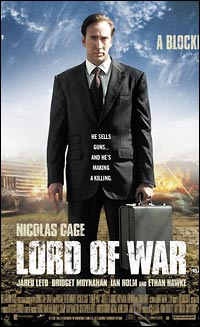
Pretend you are Yuri Orlov.
That being said Immersionists may be split on Battle Merchants, as behind the ringing anvils and clanking of coins, this battle-game-that-isn’t is fundamentally one of economic control. The theme is refreshingly different, yes, but there isn’t a lot of roleplaying to embody.
Similarly, the rough and tumble landscape of arms peddling isn’t a good domain for Socializers. Battle Merchants is a supply and demand game of pointy objects, so for this group – or anyone not a fan of managing finances in an ever-changing marketplace for 90 minutes – it won’t be a good use of your time.
Admittedly, even fans of economic games may begin to find it a little mechanically dry after many playthroughs. Factors like player size and Kingdom Cards alleviate this, though, as does the interactions between players, but the procession of every game is largely the same.
Crafting Some Space
Real war has a pretty heavy fog around it, and actual arms dealers work from the shadows. With Battle Merchants, what you get is the exact opposite.
The clarity of gameplay is easily its best attribute. The central board is crisp and bright but also devoid of unnecessary cluttering. The battlefield layout is spaced very well, and as a result, continually adding pieces to the board doesn’t leave it a jumbled mess. Even at the later stages of the game with pitched battles everywhere, you can look at the board and immediately know what is going on. You can quickly ascertain which weapons are in demand or how close the round is to ending. War itself is confusing, but the main board makes being a weapons merchant markedly simpler.
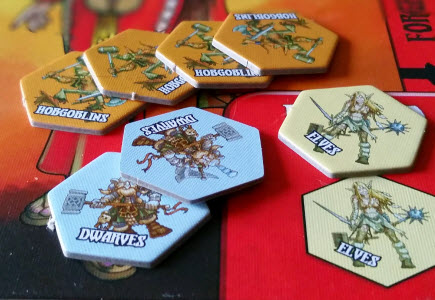
So Rewarding!
However, while this trend continues via straightforward cards and simple but effective tokens, the player boards are not as idyllic. For boards of their size, these placards have you place your weapon tokens and Kingdom cards around it, which is a little strange.
Instead, only Reward Tiles and Craft Cards are placed on them, but they are only allocated to specific corners. The placards are mostly taken up by a character portrait and summary information and would benefit from either incorporating more areas for materials or making them much smaller. The result is that you’ll need more player space than it first appears. Granted, this is a minor quibble, but a noticeable one all the same.
The difficulty tracking your Craft cards is far more noteworthy. Easily the most unwieldy part of the game, it’s essential to know how strong your weapons are when deciding what items to make and sell. Thus, Craft Cards have to be stacked such that you can see all of the icons, and they quickly bleed out of the placard confines. This is compounded when you’re leveling up multiple weapon types and when adding in dual weapon cards from the Fall / Winter deck.
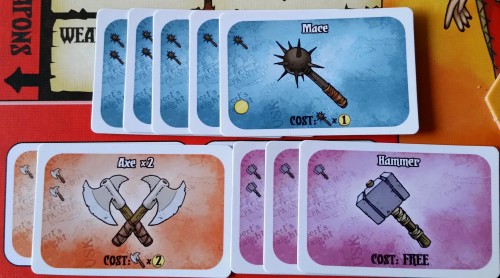
About as good as you can make it
And that’s just your own weapons. In Battle Merchants, people continually ask one another about weapon strength due to its strategic importance, and everyone will have to continually check their statuses. We feel some sort of central weapons tracker or one on the player boards themselves would reduce the only real fiddly area of an otherwise very efficient game. As it stands, though, it is rather noticeable.
More Than Meets The Eye
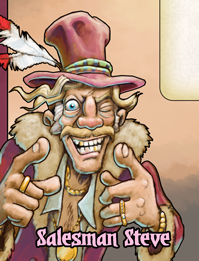
Have I got a deal for you!
Don’t let Battle Merchant’s simple design appearance fool you, though. This game is like an iceberg, with more intricacies and strategic depth than it first appears. Do you try to specialize in all four weapon types or just one? How much time do you invest in Kingdom Cards? Is making one Vorpal blade more cost effective than making three Standard ones? Battle Merchants is, after all, principally an economic management game, and these are all decisions you’ll have to make.
Unsurprisingly, Tacticians should find enjoyment navigating this world of dirty money. There are a respectable number of paths towards maximizing profits in this middleweight economic game, although it isn’t the type to have a grand reveal at the end since all information is public.
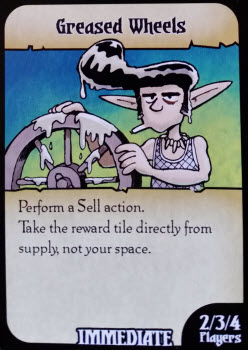 However, the fact that everything is out in the open also makes Battle Merchants an engaging game for Strikers. Economic games are hit or miss with this group, but due to the game’s low degree of luck and ability to see exactly what everyone else has, it allows for some Gordon Gekko style behavior. This can range from ending a round before other players are ready to stealing a Craft Card another player wants to selling your Mace to the only open slot. Battle Merchants may not be as combative as the wars you’re facilitating, but there is still plenty of room to interfere with each other’s plans here.
However, the fact that everything is out in the open also makes Battle Merchants an engaging game for Strikers. Economic games are hit or miss with this group, but due to the game’s low degree of luck and ability to see exactly what everyone else has, it allows for some Gordon Gekko style behavior. This can range from ending a round before other players are ready to stealing a Craft Card another player wants to selling your Mace to the only open slot. Battle Merchants may not be as combative as the wars you’re facilitating, but there is still plenty of room to interfere with each other’s plans here.
By contrast, because Battle Merchants is a game of slim margins and a tight-knit system of mechanics, there isn’t much room for Daredevils and their unconventional ways. Business has room for gambles, but not in this game; weapons dealers prefer more of a sure thing.
This conflict draws to an end…
The Takeaway
Black market dealers ultimately only care about the bottom line, so here it is: Battle Merchants is a deceptively rich game about money management. Players may not be directly involved with the demands of the game’s warring factions, but there’s still plenty of room for conflict all the same. The game’s unique arms merchant theme works on two distinct levels: both as a refreshingly different style to economic games and a proper representation of who the players are portraying. Battle Merchants has a nice presentation and is largely easy to follow, although the player board setup leaves a little room for improvement. Still, the combination of flavor and mechanics that this middleweight game brings makes Battle Merchants a worthwhile addition to a player’s gaming arsenal.
Battle Merchants is a product of Minion Games.
Cardboard Republic Snapshot Scoring (Based on scale of 5):
Artwork: 3.5
Rules Clarity: 4.5
Replay Value: 3.5
Physical Quality: 4
Overall Score: 4

